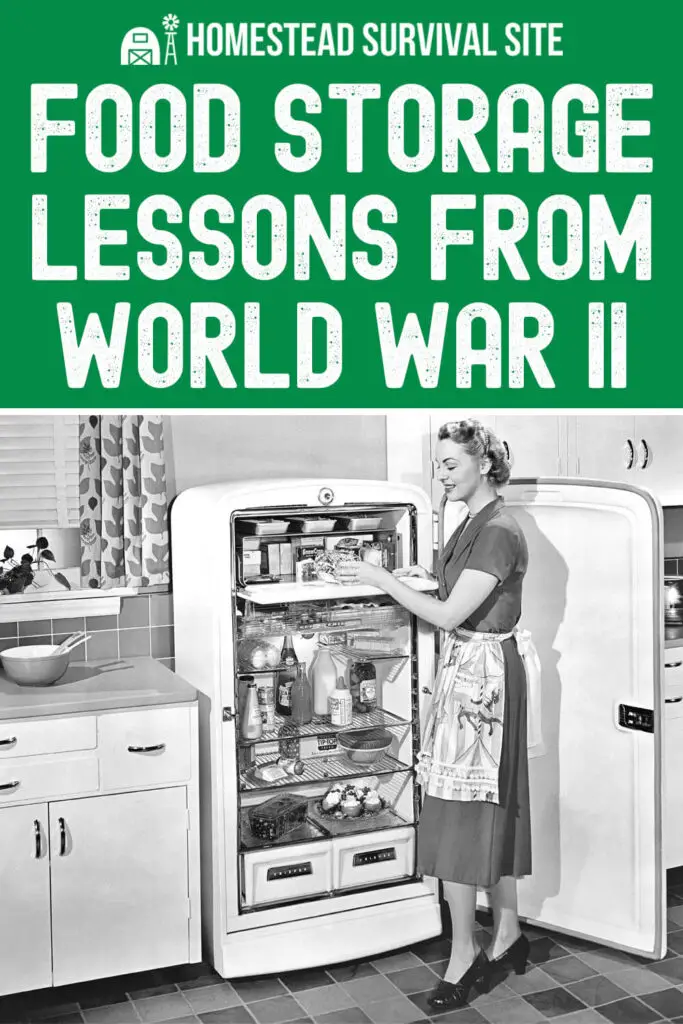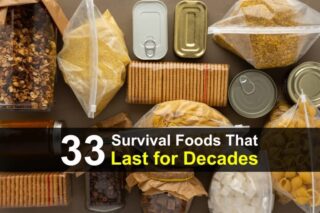Estimated reading time: 12 minutes
Concerns about food shortages are looming large once again. We may not see empty shelves in our supermarkets, like we did in the early days of the COVID-19 pandemic, but that doesn’t mean we won’t see some shortages.
The combination of food processing plants burning down, the shortage of fertilizer caused by the war in Ukraine and ongoing supply chain issues leftover from the pandemic is likely to cause us ongoing problems, even severe ones.
As a nation, we should be ready for that, especially after suffering through 2020. But even though there are more preppers today than ever, the vast majority of people aren’t any better off than they were before the pandemic started. They don’t have more food and they don’t know what to do.
Want to save this post for later? Click Here to Pin It On Pinterest!
Is Rationing Next?
Fortunately for those people, and for us as well, there are those who have gone before, who have learned how to deal with shortages. Hundreds, if not thousands, of products and commodities were rationed during the years we were involved in World War II, as we tried to not only support our troops fighting overseas, but the entire allied war effort. England, Russia and other countries were relying on our food and other supplies, so that they could keep fighting.
What that means for those here at home was tight belts and doing without. The rationing scheme put in place by the federal government was very unpopular, even while people understood and agreed with the necessity for it.
Rationing was sold to the public as a means of keeping things fair, so that the people who were working for the needs of the war effort could still get the good their families needed, rather than being beat out by those who weren’t working, so had time to get to the stores early.
People learned to make do; sometimes be making substitutions, sometimes by changing their lifestyle, and sometimes by doing things for themselves. While there was a lively black market, providing many types of rationed goods, that apparently only accounted for less than five percent of goods sold, including gasoline.
Rather than depend on the black market, most people became more creative; doing things that it would be good for us to learn from.
Rationing Coupons
The rationing system put into place by the Office of Price Administration was extremely complex. Families were issued ration coupon books for each member of the family, with different coupons being good for different categories of goods. It was necessary to pay for rationed purchases not only with cash, but with enough of the right sorts of coupons.
This created the need for people to be smart shoppers. The same sorts of coupons could often be used for a variety of differing goods, each of which required a certain number of coupon “points.” The number of points required to buy a can of applesauce or tomato paste might change from month to month, depending on the supply available and the expected demand.
Writing a shopping list therefore became a game of balancing your needs against each other, so that you would have enough points to buy everything.
Modify Recipes
People who were more creative in their cooking had a huge advantage over others; as they had the ability to adjust recipes, so as to take advantage of lower-point-cost items, while still feeding their families well.
Lower-grade, tougher, cuts of meat can still be made to taste good and even made tender, if one knows what to do. Slow cooking, such as in a crockpot, smoker, pressure cooker or sous vide can make any cut of meat tender.
Stretching Meat
Meat is a very important part of the diet, as we need protein so that our bodies can create new cells. Therefore, a diet lacking in protein can cause serious health problems. That doesn’t mean that we each need to be eating a whole steak every day; a rather small portion is actually enough.
Anyone who has ever eaten at Taco Bell should know how easy it is to stretch meat. While I hear their menu has improved, I remember a time when I wasn’t sure that you could actually get anything that was pure beef from their menu.
Back then, things were “beefy,” not “beef.” That’s because the beef was mixed with beans, stretching the meat with something that still provided protein. That same trick will work for us.
Stretching Meat – Part 2
Mixing meat with beans isn’t the only way to get it to go further. One of the easiest ways to stretch meat is to turn it into a casserole. Basically, a casserole is anything, mixed with noodles and with a sauce added.
Learn how to make white sauces, how to flavor them, and what foods mix well together and that pound of ground beef can turn into a huge, steaming bowl of tasty food; enough to even satisfy the teenagers in your home.
Sauces and gravies are actually very easy to make, even without the packaged sauce mixes in the grocery store. If you’ve got drippings from whatever meat you’re using, you’ve got the start of some good gravy. Thicken those meat drippings with a roux (equal parts of flour and butter) or by adding cornstarch. Voila, you have gravy!
Stretching Meat – Part 3
We’re actually rather picky about the types of meat that we eat here in the United States. You don’t see liver, brains, or hearts on most people’s menus. At least… not that they know about. Sometimes those things are in meat food products that we buy, but if we don’t read the ingredients list all that closely, we won’t know that they’re there.
Nevertheless, you can buy most of those parts of the animal. As I’m sitting here, writing this, I’m eating liverwurst and crackers. I’ve never made my own liverwurst, but I’ve made lots of liver pate, which is just about the same thing, with a fancier name. That works for meat, as does a lot of other “meat products” that we’re not accustomed to eating.
Doing Without Sugar
Sugar was the very first thing rationed during World War II. That may not seem like much of a big deal to some people; but anyone who bakes recognizes the need for sugar. Not only does sugar provide sweetening to baked goods, but it is also necessary anytime that yeast is used. Yeast feeds on the sugar, creating the gas which causes bread to rise.
But there are a lot of other sweet things that can be substituted for sugar, such as applesauce, honey, molasses, maple syrup, corn syrup, or sweetened condensed milk. Don’t forget about the various sugar substitutes that are out there either; both Stevia and Xylitol work well to bake with (Xylitol is actually better).
Learn to Substitute
Sugar isn’t the only food item that you might need to find substitutes for. Eggs have become extremely expensive lately and there’s no indication that the price is going to come down anytime soon. There are some egg substitutes available and we should consider those, at least for baking.
One of the reasons we use eggs in baking is that the collagen (protein) in the eggs helps hold things together. But collagen isn’t the only thing that can do that. There’s a product called Xanthan Gum, which is used for keto baking. It accomplishes the same thing. Maybe your baked goods won’t have a buttery flavor; but you can still make them taste good.
There are many other types of things that can be substituted in cooking, not just in baking. Now’s the time to start learning them, before you really need to use them.
Grow Your Own
It can fairly be said that the prepping movement has been slowly morphing into a homesteading movement. While there are still lots of preppers out there who don’t even have the room for a vegetable garden, more and more preppers are growing at least some of their own food. This was encouraged during World War II, with the government trying to talk people into growing “victory gardens.”
One thing about growing your own is that it is yours. Even with FEMA having the authority to confiscate food stockpiles, it’s unlikely that they’re going to harvest the food you’re growing in your backyard. Those are bureaucrats and they don’t believe in getting their hands dirty.
In the case of another rationing scheme, like they instituted during World War II, growing your own will allow you to use your points for other foods which you can’t grow. So, not only will you have fresh produce, which tastes better than what you can get in the grocery store; but you’ll be able to buy more of the things you still need.
In the case where there’s no rationing, but there are high prices; growing your own will free up more money to buy the expensive things you need.
Can It
If you’re growing; then it only makes sense to be canning as well. You just need to be growing enough to allow for canning. But if you’re gardening anyway, growing extra for canning purposes isn’t really much harder.
The big trick with canning from your own garden, is that you want a bunch of food ready at the same time. That actually goes against what we normally do, as with home gardening. Ideally, we want to harvest slowly, over a period of time, so that we have fresh produce for a prolonged period of time.
But with canning, we need to have enough that’s ready for harvest at the same time, so that we can get all the canning done at once. Anything else is impractical.
Make It
Some things might end up being rationed, while the ingredients aren’t. Tomato paste was rationed during most of World War II. But fresh produce wasn’t. So, people could buy as many tomatoes as they wanted to. That meant they could make their own tomato paste or tomato sauce. They could even can it, making sure they’d have enough to last a while.
As preppers, we have a real advantage in this area, as few people anymore have any idea of how to make spaghetti sauce, apple butter or jams and jellies. None of these are hard to make and as long as we have access to fresh produce, we can make all we need. For that matter, we can make extra to barter too.
Stockpile It
Canning is, of course, about stockpiling food; even for those who aren’t preppers. I’ve known people who do canning all my life, most of whom were not preppers. Yet they still had a well-stocked pantry, with enough canned goods to get through till the next year.
As preppers, we’re all about building a stockpile. But the government’s rationing scheme during World War II all but encouraged stockpiling. Even though the government told people to burn ration coupons that they didn’t use (they couldn’t be used the next month), I doubt many people did. Stores could count on a run at the end of the month, as people used up their remaining ration coupons.
Regardless of what rationing scheme or aid scheme the government puts together, we should take advantage of it. If they’re rationing a certain type of food, we want to be sure to buy our allotment. The same can be said if FEMA is passing out care packages. Not taking our care package is suspicious; so we should take it. If we don’t need it right then, we can add it to our stockpile.
Bake It
Another cooking skill that has been lost to time is baking. Even baking Christmas cookies is becoming rare; to the point where people actively seek me out, asking me for some of my cookies. Crazy. But a bread shortage, like happened during World War II, could put us all wishing we knew how to bake bread. It’s actually not all that hard.
Taking that idea a step further; think of alternate grains that you could use, rather than wheat or to extend the wheat flour that you have. Not only has the war in Ukraine hurt the world’s fertilizer supply, those two countries supply a fair chunk of the world’s wheat. We’re currently in a wheat shortage, which has caused the cost of bread to go up.
One of the easiest things to grind up and add to wheat flour, extending it, is dry oatmeal. Not only is it cheap, but once ground, works similar to wheat flour for baking. It also adds a nice flavor to the bread. Other grains can be used as well, including acorns.
Don’t let any of your bread go to waste. It’s not going to keep as long as the bread you buy in the store… mostly because it is real bread, not chemicals. If it doesn’t get eaten in a couple days, it’s time to cut that bread up and turn it into croutons.
Make the Most of Easy-to-Grow Foods
If you’re going to be growing food, then be sure to concentrate on the easy-to-grow vegetables. People love to grow tomatoes, and there’s nothing wrong with that. But it’s a whole lot easier to grow carrots and potatoes.
Not only that but both carrots and potatoes keep a long time, once they’re harvested. If you don’t have a root cellar to use, just keep them in the basement. Don’t allow them to get wet, as that will encourage mold to grow on them.
This might mean having to become a bit more creative in our cooking, as we will have more of some things than we’re used to using. That’s okay. Potatoes are extremely versatile foods, which we can do a host of different things with. They’re energy dense, so as long as you don’t have diabetics in the family to worry about, they’re a good source of carbohydrates.
Avoid Waste
I mentioned using meat drippings earlier for making gravy, rather than depending on the packaged gravy mixes. Making your own gravy out of those meat drippings can save food and money. But that’s not the only way you can use food, to avoid waste. Cooking often includes a lot of waste, which we can turn into usable food.
If you cook bacon, then you’re going to have bacon grease. In the olden days, they poured that bacon grease into an empty can or crock and saved it, using it to cook with. There’s really no sense using butter to cook eggs or cooking oil to fry potatoes, if you have bacon grease available.
Speaking of frying potatoes, people pay good money for fried potato skins in the grocery store. Maybe you’re peeling those potatoes because you’re making mashed potatoes. That’s fine; but it doesn’t mean you need to throw the skins away. Fry them up with a little salt and other seasonings and serve them to your family for a snack.
Water from boiling vegetables is another common food waste. Think about it; if you boil veggies in water, at least some of the nutrients come out in the water. Those are nutrients that your family needs. So, rather than pouring that water down the drain; save it. You can use it for soup starter, making oatmeal, or for cooking pasta. Speaking of soup, pretty much any leftovers can go into a soup.
Like this post? Don't Forget to Pin It On Pinterest!
You May Also Like:













Don’t forget foraging. Every part of the dandelion is edible, for instance, except the stem which can be split and used for insect bites. I forage for crabapples, wild grapes, dandelion root for coffee, leaves for salads and cooking and the blossoms for syrup and jellies. I make my own pectin for jams from the crabapples. There are many edible weeds, wild berries, mushrooms and nuts etc. Do not forage until you know what you are doing.